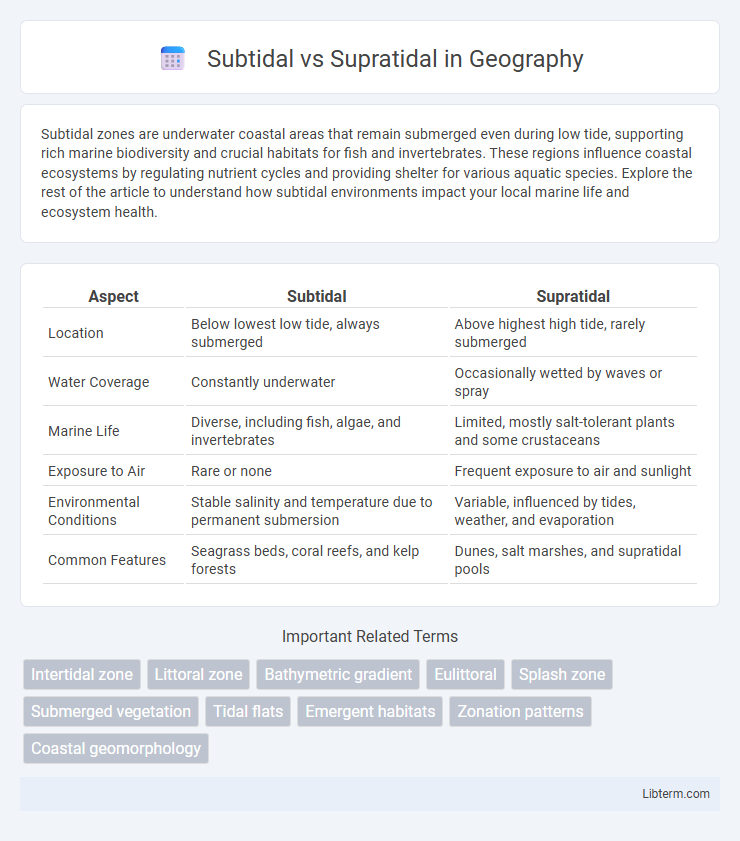Subtidal zones are underwater coastal areas that remain submerged even during low tide, supporting rich marine biodiversity and crucial habitats for fish and invertebrates. These regions influence coastal ecosystems by regulating nutrient cycles and providing shelter for various aquatic species. Explore the rest of the article to understand how subtidal environments impact your local marine life and ecosystem health.
Table of Comparison
| Aspect | Subtidal | Supratidal |
|---|---|---|
| Location | Below lowest low tide, always submerged | Above highest high tide, rarely submerged |
| Water Coverage | Constantly underwater | Occasionally wetted by waves or spray |
| Marine Life | Diverse, including fish, algae, and invertebrates | Limited, mostly salt-tolerant plants and some crustaceans |
| Exposure to Air | Rare or none | Frequent exposure to air and sunlight |
| Environmental Conditions | Stable salinity and temperature due to permanent submersion | Variable, influenced by tides, weather, and evaporation |
| Common Features | Seagrass beds, coral reefs, and kelp forests | Dunes, salt marshes, and supratidal pools |
Introduction to Subtidal and Supratidal Zones
Subtidal zones are continuously submerged coastal areas located below the low tide line, supporting diverse marine ecosystems with stable aquatic conditions. Supratidal zones lie above the high tide line, only occasionally wetted by wave splash, fostering specialized salt-tolerant vegetation and terrestrial species. Understanding these distinct tidal zones is crucial for coastal habitat mapping and marine biodiversity conservation.
Defining Subtidal and Supratidal Areas
Subtidal areas are marine zones that remain submerged below the low tide line, supporting diverse aquatic life adapted to continuous water coverage. Supratidal zones lie above the high tide mark and are only occasionally wetted by ocean spray or extreme tides, hosting specialized vegetation and organisms tolerant to saline and dry conditions. Understanding these distinctions aids in coastal ecosystem management and biodiversity conservation.
Key Physical Characteristics
Subtidal zones remain submerged under water continuously, featuring stable salinity and temperature conditions that support diverse marine life adapted to constant submersion. Supratidal zones lie above the high tide line and experience intermittent wetting from wave splash or storm surge, resulting in fluctuating moisture levels and higher salinity due to evaporation. These contrasting physical characteristics influence sediment composition, with subtidal areas having finer, more uniform sediments and supratidal zones exhibiting coarser, more variable sediments due to exposure and wave action.
Biological Communities and Biodiversity
Subtidal zones, continuously submerged below the low tide line, support diverse marine biological communities including fish, algae, and invertebrates adapted to stable aquatic conditions. Supratidal zones, located above the high tide line and only occasionally influenced by seawater, host specialized terrestrial and marine-tolerant species such as salt-tolerant plants, crabs, and insects, contributing to unique biodiversity. The contrast in water availability and exposure creates distinct ecological niches, enhancing overall coastal biodiversity through habitat differentiation.
Environmental Factors and Adaptations
Subtidal zones remain submerged underwater and experience stable salinity, temperature, and nutrient levels, supporting diverse marine life with adaptations such as streamlined bodies and gills for constant aquatic respiration. Supratidal zones are exposed to air regularly, facing fluctuating moisture, temperature extremes, and salt spray, leading to adaptations like desiccation resistance, salt excretion mechanisms, and burrowing or mobility to avoid harsh surface conditions. Environmental factors in these zones drive distinct physiological and behavioral adaptations, reflecting the contrasting challenges of continuous submersion versus periodic exposure.
Ecological Roles and Functions
Subtidal zones, consistently submerged, serve as critical habitats for diverse marine species and support nutrient cycling through complex food webs. Supratidal zones, rarely flooded, function as buffer areas protecting inland ecosystems from saltwater intrusion and provide nesting grounds for various bird species. Both zones contribute uniquely to coastal ecosystem stability by regulating sediment dynamics and supporting biodiversity.
Human Impacts and Threats
Subtidal zones, continuously submerged underwater, face threats from pollution, habitat destruction, and overfishing, which disrupt marine biodiversity and ecosystem services. Supratidal zones, exposed to tidal influences but usually dry, are increasingly impacted by coastal development, pollution runoff, and human trampling, leading to habitat degradation and loss of native vegetation. Both zones suffer from climate change effects, including sea-level rise and increased storm frequency, intensifying erosion and salinity changes that threaten their ecological integrity.
Conservation and Management Strategies
Subtidal zones, constantly submerged and rich in biodiversity, require conservation strategies focused on protecting marine habitats from pollution, overfishing, and habitat destruction through marine protected areas and sustainable fishing practices. Supratidal zones, located above the high tide line and exposed to air, need management strategies addressing coastal development, erosion control, and pollution prevention to preserve vital buffer zones and support terrestrial-marine ecosystem interactions. Effective conservation integrates habitat restoration, monitoring programs, and community engagement tailored to the distinct ecological functions and threats of subtidal and supratidal environments.
Research Methods and Monitoring
Subtidal and supratidal zones require distinct research methods and monitoring techniques due to their differing environmental conditions and biological communities. Subtidal studies often utilize underwater sensors, remote sensing technology, and diver-based observations to continuously track aquatic parameters such as salinity, temperature, and biodiversity. Supratidal monitoring relies on sediment sampling, vegetation surveys, and automated climate stations to assess terrestrial influences, tidal inundation frequency, and habitat changes over time.
Summary: Subtidal vs Supratidal Comparison
The subtidal zone lies below the low tide mark and remains submerged, characterized by stable aquatic conditions supporting diverse marine life, while the supratidal zone is positioned above the high tide line, experiencing periodic inundation from waves and spray, resulting in harsher environmental conditions. Subtidal areas often feature seagrass beds, kelp forests, and abundant fish populations, contrasting with the supratidal zone's salt-tolerant vegetation like mangroves and salt marsh plants adapted to dry, saline conditions. Differences in tidal influence, hydrodynamics, and ecological niches create distinct habitats critical for coastal ecosystem biodiversity and resilience.
Subtidal Infographic

 libterm.com
libterm.com